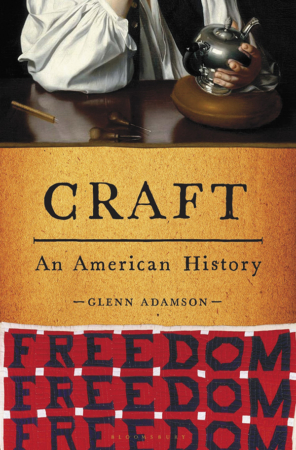You are pretty handy.
That thing you made – you did it yourself, with a minimum of help and it looks fabulous. It’s almost a professional piece and you have reason to be proud. Look what you made, just look at it, then read “Craft: An American History” by Glenn Adamson and see if your ancestors would approve.
Tens of thousands of years ago, humans began crafting which, by definition, means the act of a skilled individual creating something by hand. For them, though, crafting was less fun, more a means of survival.
It was the same when Europeans came to America: though the Pilgrims were said to be quite taken with baskets made by Native weavers, craftsmen from back home were in demand to make clothing, plow blades, horseshoes, and such that life then required. Today, we tend to romanticize those craftsmen but the truth is that the work was largely repetitive and there was rarely any room for creativity.
Even so, the ability to utilize a valuable skill was, well, handy. It ensured work immediately and for the next generation, since tools and know-how were often passed down, parent-to-child. For slaves, having a craft might offer an edge on being kept, rather than sold away; freedmen, though sometimes fired because of white protestations of job loss, used their work to purchase freedom for family members. In those cases, knowledge and skills of a craft gave Black craftsmen and women opportunities that they mightn’t have had without one.
When items began to be mass-produced, the value of craftwork shifted: suddenly, clothing could be made without a wait, and factory-made kitchenware was less expensive. Elite craftsmen were held in higher esteem, even though much of their product was done by “outworkers” who did the actual work. Women, at the same time, were taught homemaking skills – some of which were, when you look at them now, crafts.
Today, says Adamson, “Relatively few of us actually perform crafts anymore,” although our definition of “crafts” seems to be shifting once again…
Let’s start here: this is not a craft manual. It has no patterns, no instructions, and no ideas for you to alter creatively. Instead, “Craft: An American History” leans entirely on the last word in its subtitle, blending it with several cultures in time.
The other difference between this and a craft manual is that this book isn’t as relaxing as is, say, sewing or woodworking might be. Author Glenn Adamson leans deeply into the background and meaning of craftsmaking, beginning with a time before the Pilgrims and moving forward to “craft breweries and tattoo parlors…” The focus is on the kinds of crafts one might practice as a livelihood, while today’s conventional “crafts” as we know them – crochet, knitting, metalwork, needlework, jewelry-making – are covered very little, if at all.
That may make a historian happier with this book than a cross-stitcher might be, but there’s something for both inside “Craft: An American History.” Just keep in mind its depth so find it, but keep a bookmark handy.
“Craft: An American History” by Glenn Adamson
c.2021, Bloomsbury Publishing
$30.00 / $39.99 Canada
387 pages





Leave a Comment
Your email address will not be published. Required fields are marked with *